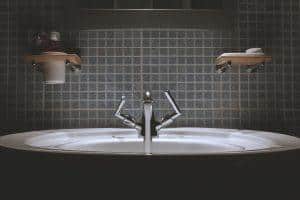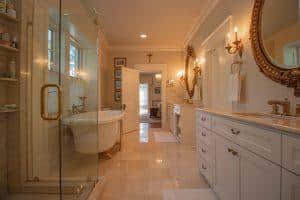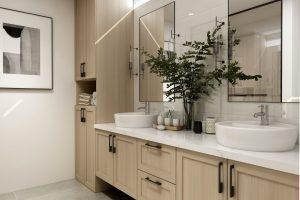
When it comes to the bathroom remodeling process, many homeowners are actually unaware of the stages their bathrooms will go through from the beginning to the end of the process. Despite being one of the smallest spaces in your house, the scope of a bathroom remodel, and the intricacies involved make it one of the most complicated home remodeling projects.
Even a bathroom measuring a few hundred square feet, due to its compactness, can pose a significant challenge when you and your contractor set out to change the tiles, replace the plumbing, repair the walls, and install appliances.
Similarly, the dimensions of your bathroom and the materials you choose greatly influence the cost of your bathroom remodel. To complete the renovation, you need to be prepared and willing to be flexible in your budget as well as the process.
A properly renovated bathroom reflects the aesthetics of your home well and offers you great comfort. For that, you must ensure that everything is done right. In this article, we will take you through every step of the bathroom remodeling process.
Planning Your Budget
Before you begin the bathroom remodeling process, you must plan everything out and know how you want the work to proceed. To do so, you should find out as much as you can about the cost of the materials involved.
The actual costs of the bathroom remodel can potentially go much higher than you can imagine. Depending on the materials you choose and the number of items you decide to replace, you may have to spend thousands of dollars. Just like the materials, the final budget also depends on the kitchen remodeling contractor that you choose.
While choosing a contractor, make sure you enquire properly about their terms and conditions. Communicate your needs well to them. You should also ask them if they will be able to get you discounts on lighting, tile, fixtures, or paint. The main reason behind doing this is that you should have an accurate idea about the costs and details of the materials involved as well as the contractor’s terms and conditions.
While you’re planning your remodel, decide the scope of your bathroom remodel beforehand. Think well whether you are satisfied with minor changes or want an upscale bathroom remodel. If you are interested in remodeling your bathroom layout, you should develop a new floor plan at this point. Ask your plumber and electrician for accurate estimates regarding plumbing and electrical costs, respectively.
Demolishing
After you have planned out everything, including your budget, proceed with the demolition part of the bathroom remodeling process. It is a systematic process but does not require you to hire professionals.
Begin by turning off the electricity and water supply of your bathroom. After this, you can remove old tiles, flooring, and fixtures. Do not forget to check for water damage beneath the flooring and check for mold and mildew growth.
During the demolition process, you must make sure that you do not damage anything you will need in the future. For example, be careful while pulling out the sink or toilet. Removing every piece in parts can potentially help you save a lot of time.
Some homeowners tend to opt for countertop or tile refinishing during the bathroom remodeling process. In that case, you can remove the tiles or countertop without any hesitation.
You can easily reseal your countertop or tile and alter its color with professional refinishing. You won’t have to pay anything for the new tiles, and thus you can save a lot of time and money during the bathroom remodel.
Plumbing Adjustments

After you’ve demolished the bathroom, you will have to replace and install plumbing. This includes a waterline extension, toilet flange, new shower pan, and any necessary modifications for installing another sink.
For that purpose, you should definitely try to choose the right remodeling contractor. Show them where you want to install each fixture and ask them to move the plumbing according to that.
Before moving around with fixtures, you will have to install the new plumbing. If your bathroom already has a great layout, you should purchase fixtures compatible with the plumbing you already have. That will help you save on the costs of hiring a professional plumber.
After that, you can work on the wiring as well. Keep in mind that this step is much easier when the walls are open. Focus on replacing the wiring and relocating or installing the exhaust fan or outlets.
Close the Walls
Once the electrical and plumbing work has been done, you may proceed to close the walls. Install blocking for the grab bars if required.
When you are completing the walls, try to put up vapor barriers and a cement board in your tub and shower stall’s moist areas. The cement board will enable your wall tiles to resist moisture. For other walls in your bathroom, you can go for drywall.
Begin to Paint Your Bathroom

After the bathroom walls have been closed, proceed to paint them up properly. We recommend choosing interior paint with a semi-gloss or satin finish, which will protect the wall from moisture.
Remember that you must paint the walls before you install the tub, sink, toilet, vanity, tiles, and other accessories. That will help you avoid the mess created by the inevitable splashing of paint.
Install the Tiles

With the painting job done, you can start working on the tiling. Ideally, you should give priority to tiling the bathtub enclosure and shower walls before any other area in your bathroom.
After that, you can proceed to install the wall tile and finally the bathroom flooring. You can buy grout in various colors from almost every kitchen and bath showroom near you. Try using grout to stick it on, or put it correctly for both the floor and wall tiles.
Depending on the setup of your bathroom, you can choose to install both the floor tile and wall tile at the same time. In fact, they will be put up simultaneously if you are getting your tub and tile refinished.
Installing the wall tile is not too different from installing the floor tile. It takes a day for the tile to set and an additional 24 hours for the grout to get dried up. At this point in the process, you can slowly start seeing your new bathroom come to life.
Install the Shower Doors

Once you have securely installed the wall tiles and flooring, you can proceed to put up the track door for your bathtub, shower door for the enclosure, or a curtain rod to hang curtains around the cubicle in your shower. You can thus start completing the shower remodel part of the bathroom remodeling process.
Add the Exhaust Fans and Lighting Fixtures
With the fundamental steps of the bathroom remodel successfully completed, you can start the work on your lighting fixtures. Ideally, your bathroom should have soft lighting that is bright enough to light it up adequately.
You can put up lights right over the sink to brighten up your bathroom. Many homeowners tend to put up both ceiling and wall lights in their bathrooms as well.
Apart from lighting, you need to get exhaust fans installed as well. Do not ignore the importance of this step. After all, these fans are vital for maintaining the hygiene and cleanliness of the air in your bathroom.
Install the Sink and Vanity

Once the electrical work has been successfully completed, you will have to work on the plumbing. Get the sink and vanity aptly positioned and hook up the plumbing to them. It is a relatively simple task for which you can opt for a DIY approach as well.
That said, you definitely need to get professional assistance for actually connecting the plumbing to these fixtures. Luckily, it does not really cost a lot. Ensure that your new vanity is properly anchored to the wall for security and safety. Vanities tend to be quite cost-effective and simple to install in general.
Install the Toilet
Fortunately, installing the toilet is by far the easiest part of the bathroom remodeling process. You can readily opt for a DIY approach here without paying additional money for hiring professionals. You can easily find the instructions for how to move a toilet online.
However, if you are new to the DIY world and if you are willing to invest in professional assistance to get the best results, you can do so.
Add the Accessories
Everything else in your bathroom, like the plumbing, flooring, and tiling, has been taken care of at this point. Thus, you can move on to the last step of the bathroom remodeling process – putting up the accessories.
Add those finishing touches by adding shelves, towel bars, light switch plates, and other accessories you would like to have in your bathroom. These features are usually fast and simple to install.
By waiting until the rest of your bathroom remodeling process is complete, you will be able to choose the finishes, styles, and colors for your bathroom accessories.
With the bathroom remodel now complete, you can enjoy a moment of peace and sanctuary in your newly renovated space.